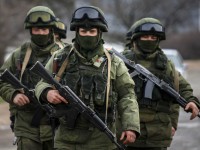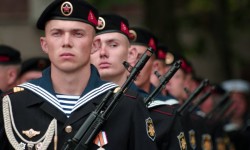The Russian army is part of the Russian armed forces as a land force. Like most modern armed forces, the Russian army is divided into the Army, Navy and Air Force divisions. In addition, there are in Russia the independent parts of the airborne force, strategic missile force and the space force.
The current army was founded after the collapse of the Soviet Union in 1992 and consists largely of material from Soviet stocks. With approximately 395,000 soldiers (including 190,000 conscripts), the army provides the largest part of the armed forces of the entire army and is divided across the country in 4 military districts:
United Strategic Command Center with staff in Yekaterinburg, Sverdlovsk Oblast
- 2nd Army with staff in Samara, Samara Oblast
- 41st Army with staff in Novosibirsk, Novosibirsk Oblast
United Strategic Command East with staff in Khabarovsk, Khabarovsk Krai
- 5th Army with staff in Ussuriisk, Primorye region
- 29th Army with staff in Chita, Transbaikalia region
- 35th Army with staff in Belogorsk, Amur Oblast
- 36th Army with staff in Ulan-Ude, Buryat Republic
United Strategic Command South with staff in Rostov-on-Don, Rostov Oblast
- 49th Army with staff in Stavropol, Stavropol Territory
- 58th Army with staff in Vladikavkaz, Republic of North Ossetia-Alania
United Strategic Command West with staff in St. Petersburg
- 6th Army with staff in Agalatovo near Sertolovo, Leningrad Oblast
- 20th Army with staff in Voronezh, Voronezh Oblast
Crews
- рядово́й (Soldier)
- ефре́йтор (Private first class)
Unlike other forces, the Russian army has only 2 crew ranks.
рядово́й (Soldier) (1), ефре́йтор (Private first class) (2)
Noncommissioned officers
- мла́дший сержа́нт (non-commissioned officer)
- сержа́нт (Sergeant)
- ста́рший сержа́нт (Technical sergeant)
- курсант (officer cadet)
- старшина́ (Csm)
мла́дший сержа́нт (non-commissioned officer) (3), сержа́нт (Sergeant) (4), ста́рший сержа́нт (Technical sergeant) (5), курсант (officer cadet) (6), старшина́ (Csm) (7)
Praporschtschik
- пра́порщик (Praporschtschik, similarly rank wo1)
- ста́рший пра́порщик (Starschij praporschtschik, similarly rank cw2)
пра́порщик (Praporschtschik, similarly rank wo1) (8), ста́рший пра́порщик (Starschij praporschtschik, similarly rank cw2) (9)
Officers
- мла́дший лейтена́нт (Under lieutenant)
- лейтена́нт (Second lieutenant)
- ста́рший лейтена́нт (first lieutenant)
- капита́н (Captain)
- майо́р (Major)
- подполко́вник (lieutenant colonel)
- полко́вник (Colonel)
мла́дший лейтена́нт (Under lieutenant) (10), лейтена́нт (Second lieutenant) (11), ста́рший лейтена́нт (first lieutenant) (12), капита́н (Captain) (13), майо́р (Major) (14), подполко́вник (lieutenant colonel) (15), полко́вник (Colonel) (16)
Generals
- генера́л-майо́р (major general)
- генера́л-лейтена́нт (lieutenant general)
- генера́л-полко́вник (Colonel general)
- генера́л а́рмий (general of the army)
- Ма́ршал Росси́йской Федера́ций (Marshal of the Russian federation)
генера́л-майо́р (major general) (17), генера́л-лейтена́нт (lieutenant general) (18), генера́л-полко́вник (Colonel general) (19), генера́л а́рмий (general of the army) (20), Ма́ршал Росси́йской Федера́ций (Marshal of the Russian federation) (21)
You can find the right literature here:
The Modern Russian Army 1992–2016
Since the collapse of the Soviet Union, Russia's army has undergone a turbulent transformation: from the scattered leftovers of the old Soviet military, through a period of shocking decay and demoralization, to the disciplined force and sophisticated “hybrid war” doctrine that enabled Vladimir Putin to seize Crimea virtually overnight in 2014.
Using rare photographs and full-color images of the army in action, profiles of army leaders and defense ministers, as well as orders of battle and details of equipment and dress, this is a vivid account of the army's troubled history and of its current character, capabilities and status.
Written by an internationally respected author with remarkable access to Russian-language sources and veterans, this study is essential reading for anyone wishing to understand the growing power of Russia's military.
The Russian Military Resurgence: Post-Soviet Decline and Rebuilding

The Russian Military Resurgence: Post-Soviet Decline and Rebuilding, 1992-2018 Paperback – November 27, 2018
The transition from the Soviet to the post-1991 Russian military is a fascinating story of decline and reinvention. The Soviet army suffered a slow demise, dissolving in 2000 and only gradually reforming based on radically different principles. The First Chechnya War (1994-1996) was the lowest point for the Soviet military but the Second Chechnya War (1999-2004) saw the initial stirrings of the new Russian army. The Five Day War with Georgia in August 2008 was its first major success and marked Russia's return to world power status.
Lively accounts and maps describe the actions of these wars, along with the Crimea operation of 2014, the separatist struggles in eastern Ukraine and the ongoing Russian intervention in Syria.
Armies of Russia's War in Ukraine
Using his extensive contacts in both Russia and Ukraine, and access to a mass of official and unofficial sources, Mark Galeotti presents a thorough and intriguing primer on all the forces involved in the ongoing conflict in the Ukraine. Supported by specially commissioned artwork, he analyzes both the progress of the war, and what it teaches us about Russia's current military capabilities.
In February 2014, street protests in Kiev and other Ukrainian cities led to the ousting of the Russian-backed President Yanukovych. The so-called Euromaidan Revolution saw many changes to the Ukraine's constitution, but the violent reaction in the east and south of the country led to armed counter-revolution, unofficially backed by Russia.
This conflict is the essential example of Russia's new policy of "hybrid warfare", which blends propaganda, misinformation, and the deployment of "deniable" Special Forces and regular troops alongside proxies and mercenaries to achieve its strategic ends.
Modern Russian Tanks & AFVs: 1990-Present
Created from what was left of the gigantic stockpiles of Soviet armored fighting vehicles after the end of the Cold War, the Russian armored forces were reorganized in the early 1990s. Modern Russian Tanks & AFVs explores the main battle tanks, armored fighting vehicles, armored personnel carriers, self- propelled guns, and missile-launching platforms in service since then, when ground forces engaged in a series of conflicts in border states from Chechnya to the Crimea to the Ukraine. Organized by type and then alphabetically by manufacturer, the entries include the BMD-3, BMPT Terminator, T-90 and T-15 main battle tank, and the Buk missile system responsible for shooting down the Malaysian Airlines 777 jet over Ukraine in 2014. Expert profile artworks illustrate each entry, which also includes complete technical specifications, making this a must-have reference for anyone interested in modern military technology.
This post is also available in:
 Deutsch (German)
Deutsch (German)  Français (French)
Français (French)  Italiano (Italian)
Italiano (Italian)  简体中文 (Chinese (Simplified))
简体中文 (Chinese (Simplified))  Русский (Russian)
Русский (Russian)  Español (Spanish)
Español (Spanish)  العربية (Arabic)
العربية (Arabic)



















